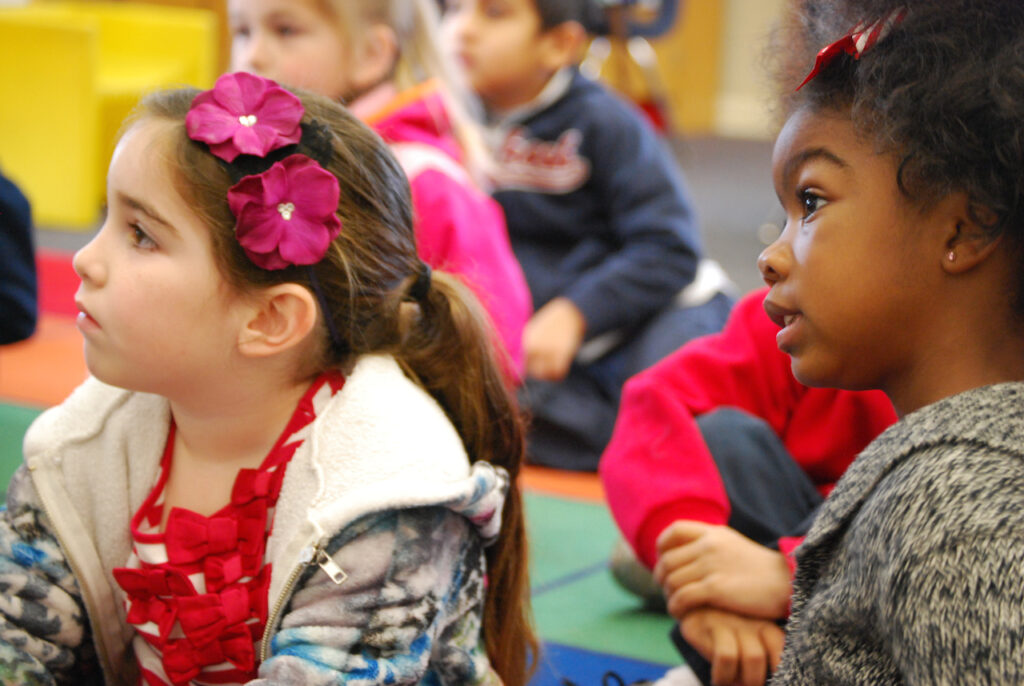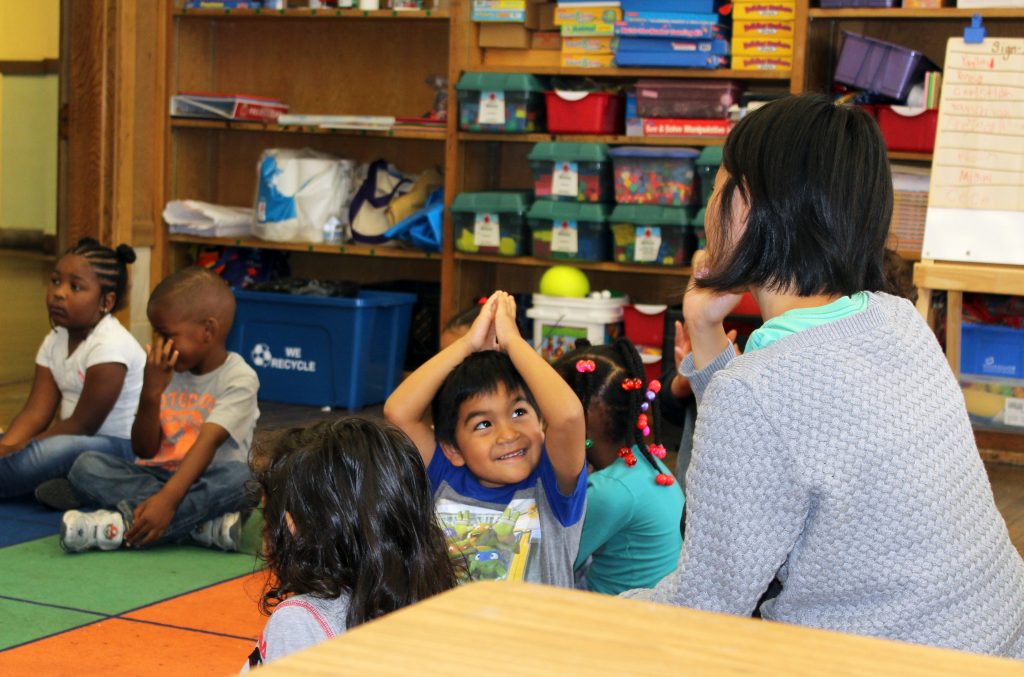
Students listen to their teacher during a transitional kindergarten class in Long Beach.
Credit: Lillian Mongeau/EdSource Today
Top Takeaways
- Transitional kindergarten, or TK, becomes available to all 4-year-olds in the fall.
- Smaller child-to-staff ratios, 10-to-1, are slated to start in the 2025-2026 school year.
- Early exposure to the basics of reading and math can kick-start academic achievement, experts say.
Paula Merrigan loves being a transitional kindergarten (TK) teacher so much she says she may never retire. She’d miss the wonder of a class filled with hugs, light bulb moments, and little ones who call her mom. She’d miss sitting cross-legged on the alphabet rug, hearing plans for a cat birthday party.
In teaching, a field often beset by burnout and high turnover, TK stands out as a joyous and messy world of puzzles, finger painting and puppet theater, a world unique from the rest of the K-12 system. This fall, California’s long-awaited vision of universal pre-kindergarten finally comes to fruition as transitional kindergarten, or TK, becomes accessible to all 4-year-olds across the state.
“I love working with this age,” said Merrigan, 57, a veteran teacher holding court in a classroom jam-packed with construction paper butterflies, hearts and Dr. Seuss characters. Merrigan has spent 17 years teaching kindergarten and transitional kindergarten in the Castro Valley Unified School District. “They’re so happy to come to school. They take genuine pleasure in learning. They enjoy it. They want to be here. They have a really good time, and so do I.”
Spearheaded by Gov. Gavin Newsom and Assemblymember Kevin McCarty, D-Sacramento, the roughly $3 billion program has been described by many experts as a game-changer for families in a state with about 2.6 million children under the age of 5. Many hope that increasing access to preschool may be one of the keys to closing the state’s ever-widening achievement gap. Given that about 90% of brain growth happens before kindergarten, perhaps it should come as little surprise that children who attend preschool are more likely to take honors classes and less likely to repeat a grade or drop out of school, research suggests.
“We know that early childhood experience strongly influences cognitive development and that many of the problems that become evident later in life, including high rates of failure, are set in motion before children enter kindergarten,” said W. Steven Barnett, the senior co-director of the National Institute for Early Education Research (NIEER), which is based at Rutgers University. “We have strong causal evidence for links with educational attainment that has high payoffs over a lifetime.”

Once lagging behind the rest of the country in preschool access, some say California may now be poised to lead the way. The state now ranks 13th in the nation in preschool enrollment for 4-year-olds. That’s up from ranking 18th for 4-year-old access in 2023, according to a national NIEER report that ranks state-funded preschool programs.
“California’s TK is huge for the early childhood education field,” said Barnett. “The state is getting closer each year to achieving its goal of universal preschool for 4-year-olds.”
A stepping stone between preschool and kindergarten, TK began in 2012 as a program for “fall babies,” children who narrowly missed the cutoff date for kindergarten. Now it’s been expanded to function as a kind of universal pre-kindergarten initiative. Yet even as TK is set to become a real grade, just like any other K-12 grade, there are myriad challenges looming on the horizon, from finding qualified teachers amid a dire staffing shortage to how to ensure quality instruction and suitable facilities. Class size and specialized teacher training are among the major concerns.
California will need roughly 12,000 extra teachers and about 16,000 aides to keep the TK rollout on schedule, research suggests.
“More TK students means districts need more TK teachers,” said Gennie Gorback, an early childhood educator and president-elect of the California Kindergarten Association. “Because TK is a special grade that requires credentialed teachers to have additional early childhood education units, it’s more of a challenge to find qualified teachers.”
Candidates need a bachelor’s degree, must complete courses in child development or early childhood education, take the state’s teacher performance exam and log 600 hours in the classroom. Without pay. Those requirements may be holding back preschool teachers, who already teach 4-year-olds, from taking better-paying TK jobs, experts say.
“We feel from a position of equity and respect for the experience of preschool teachers that the current pathways are still inadequate,” said Anna Powell, senior research and policy associate at Berkeley’s Center for the Study of Child Care Employment (CSCCE). “If 4-year-olds are moving into TK, some of their highly skilled teachers should have a streamlined pathway to go with them.”
Quality also remains a key issue. The NIEER report scored California’s TK program a mere 3 out of 10 criteria, largely for having a crowded class size of 24 children in a classroom and an average 12-to-1 student-to-staff ratio. Teacher training is also a factor.
“Building quality is job one for the future,” said Barnett. “Providing guidance and continuous improvement so that TK develops as a program appropriate for 4-year-olds.”
Newsom’s latest 2025-26 budget sets aside $1.2 billion to add new students and also help reduce TK staff ratios to 10-to-1, slated to start in the 2025-2026 school year.
“Low spending results in low quality,” according to the report. “While that may seem to save money, it is wasteful and costly in the long run to fund programs that do not adequately support long-term gains and may even harm long-term outcomes for some children.”

Small class sizes are critical, experts say. For the record, the gold standard for the early education sphere is more like 8-to-1, like the state’s public preschool program, which met six out of 10 benchmarks.
“The real key is a small ratio,” said Gorback. “Having more adults in the room helps ensure that each child gets the attention and guidance they need.”
Play is the heart of learning at this age. Merrigan’s classroom encourages guided play that enhances learning, such as math games students beg to play and a kinetic sandbox that sparks creativity and motor skills.
“I love to watch the aha moments,” said Merrigan, who tested out many activities on her own son to see if they were fun as well as edifying. “I love seeing kids who come in knowing no letters and no numbers, and they leave knowing every letter and every sound. It’s amazing. And we do it all through play.”
Another roadblock is that some school districts don’t have enough space and facilities for TK classrooms or the resources to add everything from potties to playground equipment sized for 4-year-olds. Some Oakland schools, for instance, don’t have any TK classrooms, which is why some children end up on wait lists for their preferred school.
“Space is an incredible challenge for schools,” said Gorback. “Most elementary schools were not built with TK classrooms in mind, so administrators are having to get creative in making sure that all of their young learners have the space they need.”
After declining during the pandemic, TK growth has been accelerating. Enrollment jumped by more than 35,000 children from the previous school year, according to Bruce Fuller, professor of education and public policy at UC Berkeley, now standing at roughly 151,000, but the rub is that the bump in TK enrollment may have come at the expense of other programs. Some families simply switched from one program to another.
“Enrollments in center-based programs have stalled overall,” Fuller said.
Certainly, ushering in a new grade at a time of profound upheaval, from learning loss to chronic absenteeism in the school system, may be an unwieldy challenge, experts say, but it also should be noted that early education can have the greatest impact now, even as the youngest learners struggle to recover from the damage caused by pandemic-era school closures.
“TK absolutely can help with pandemic recovery and with changes that we see in children’s development that persist,” added Barnett, “but this will require focused attention to ensure good practice, ensure children with the greatest needs enroll, and ensure high attendance rates when they do enroll.”


